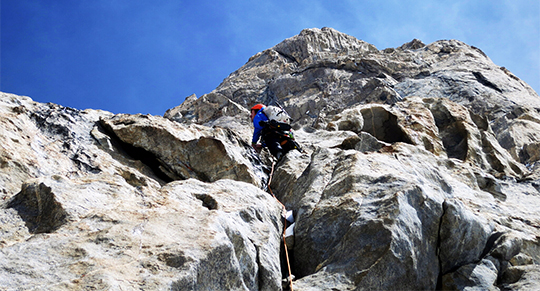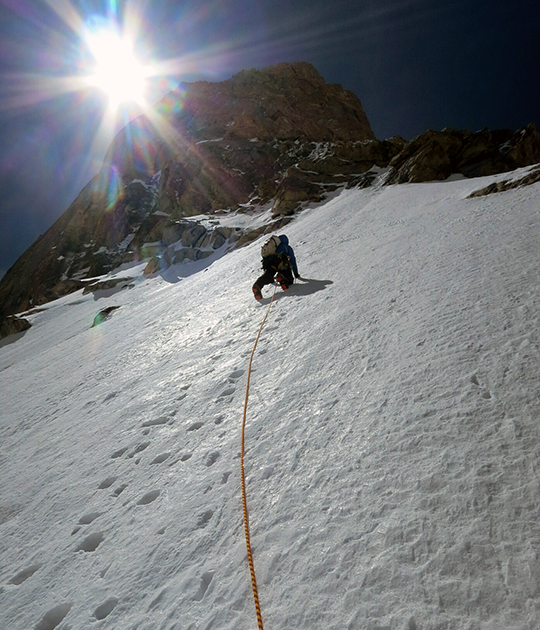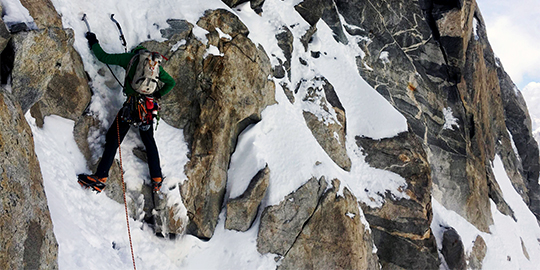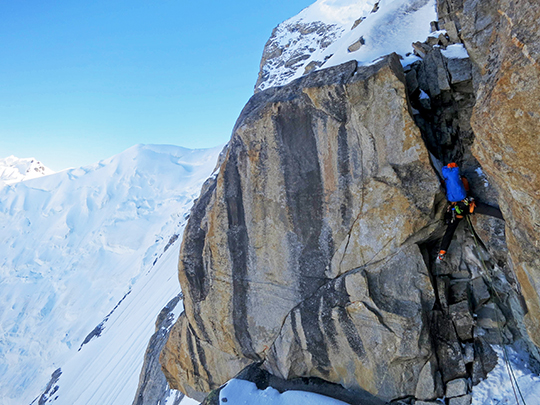
[Photo] Scott Bennett
Scott Bennett wasn’t about to let a variable phone connection keep him from sharing news about his team’s new route on K6 West’s (7040m) Southwest Ridge. Over static he talked to Alpinist about his first expedition to the Karakoram.
On July 6 the trio arrived in Skardu, the launching point for their expedition. This was Bennett, 30, from Boulder, Colo., and Zimmerman’s, 29, from Bend, Ore., first trip to the region. Steve Swenson, twice their age, from Seattle, Wash., had been on fifteen expeditions to the region over the past 35 years. During this trip the team made the first ascent of Changi Tower’s (6500m) North Ridge (M6 5.10 A2, 600m), and the second ascent of K6 West (7040m) via the first ascent of the Southwest Ridge (M6 90 degrees, 1800m).
[Read about the first ascent of K6 West in the NewsWire from August 12, 2013, here–Ed.]
The men timed their ascents through small weather windows amid falling rain and snow. “We called Jim Woodmency, a meteorologist out of Jackson Hole, [Wyo.] up every week or more and he would look at the weather and break it down for us. We were getting rain at base camp at 4500 meters and there was snow at 6000 meters, [but what we] wanted to climb was getting snow,” Bennett said from a hotel courtyard in Skardu.

[Photo] Scott Bennett
The team began their climb on August 8 after establishing a safe passage through an icefall at the base of Changi Tower’s (6500m) North Ridge, described by Bennett as “a huge maze of crevasses and teetering towers.” They moved quickly through the complex icefall before starting up the lower ice fields leading to the North Ridge of Changi Tower. Continuing up the first 300 meters of the tower, Bennett, Swenson and Zimmerman reached the site of their first bivy. Here they reinforced a ledge with a tarp held in place with ice screws that they backfilled with snow and ice to widen the platform. Looking up on the ever-steepening wall, likely void of any substantial bivy ledges, they decided to climb the route in two instead of their planned three days.
On day two they pushed up the remaining 300 to 400 meters to the summit, encountering “perfect Styrofoam ice,” Bennett said.
According to Bennett, they aimed toward a dihedral capped with an “overhanging offwidth with hanging icicles,” cutting up the face. Nearly halfway up the open book, they switched their ice tools and crampons for rock shoes and climbed 5.10 terrain through roof cracks of varying sizes. Nearing the overhanging offwidth, which they didn’t have the gear to protect, the team began looking for an exit. Bennett led a ten-meter runout traverse on 5.9 huecos that brought them to a ledge under low-angle snow leading to the top. They reached Changi Tower’s summit at last light. Eighteen rappels down the route brought the team back to the glacier.
Back at base camp, the team aimed for their primary objective, the South Face of K6 Central (7100m). While scouting the route, a serac fell from the route’s upper reaches and scoured their intended line. Searching for a new route, they found a promising line on the far western end of the K6 massif. “We’re a conservative team when it comes to the risks and objective hazards,” Bennett said.
They set their eyes on the striking Southwest Ridge of K6 West (7040m), offering “huge relief, steep mixed ground and a line free of objective hazard,” Zimmerman recalled. On August 15, the team received a good weather forecast from Woodmency indicating high pressure for the foreseeable future.
With an open weather window ahead, the climbers hoped to take a few days to recover.

[Photo] Graham Zimmerman
Their plans changed when Woodmency notified them of a severe storm expected to arrive on August 21. This wasn’t enough time for Swenson to get his energy back. With Swenson out, only Bennett and Zimmerman departed base camp on August 17 at 10 p.m.
Under lightly falling snow, the duo traveled along a lateral moraine on the West Nangmah glacier to reach their small gear cache. Once at the cache, they rested for a few hours and by daybreak the storm had cleared.
From the glacier at 5100 meters, they climbed unroped along a snow and ice field to gain the ridge under warm and slushy conditions. Here, they set up an unplanned bivy on top of a steep snow slope at 5800 meters and waited for cooler conditions.
Starting up the Southwest Ridge at 3 a.m., the duo climbed firm neve. When the ridge became too heavily corniced, they traversed onto difficult mixed terrain on the steep north side of the ridge. Near daybreak, they navigated a series of ledges alongside a buttress, negotiating M6 terrain over pale-gray granite streaked with black. Soon the men reached a steep ice sheet leading to the top of a second buttress at 6600 meters where they set up their next bivy.
Departing at sunrise and leaving their tent in place, they climbed the remaining 400 meters of thinly crusted knee-deep snow. The final stretch took them five hours of kicking steps while “nearly drunk from the lack of oxygen,” Bennett said. They reached the summit at 1 p.m., completing the second ascent of the peak.

[Photo] Scott Bennett
After returning to their tent at 4 p.m., the pair waited until nightfall to descend the west face when colder temperatures would make conditions safer. Fighting off sleep with Gu and caffeine tabs, Zimmerman led the pair down twenty V-thread rappels through the night bringing them level with their first bivy but still 500 meters to the north. After a long traverse on steep snow, they climbed a short pitch of vertical ice to regain the Southwest Ridge and reach their camp. Seven rappels later they arrived back at the base of the route on the glacier.
That night it began to snow. After waiting out a storm for three days, the men made their way back to town.
We caught up to Bennett soon after he and his team enjoyed a haircut and shave, “still on the high from climbing,” Bennett said. “It’s been a long trip.”


[Photos] Scott Bennett
“It needs to be noted that there has been some confusion about the name Changi as a peak in the Amin Brakk group named Changui Tower (5700m) has in the past been misreported as Changi Tower,” Zimmerman wrote in a press release. “This mistake was found by a Polish team who attempted Changi Tower (6500m) in 2010 and has been confirmed by research completed by this 2015 team.”